Extraction of Anthocyanins from Borage (Echium amoenum) Flowers Using Choline Chloride and a Glycerol-Based, Deep Eutectic Solvent: Optimization, Antioxidant Activity, and In Vitro Bioavailability
Abstract
:1. Introduction
2. Results and Discussion
2.1. FTIR Spectra, Viscosity, pH, and Conductivity of CHGLY
2.2. Screening CHGLY Efficiency vs. Conventional Solvents
2.3. Optimization of Extraction Conditions
2.4. Multi-Response Optimization on the Responses Using RSM
2.5. In Vitro Bioavailability
3. Material and Methods
3.1. Plant Material
3.2. Chemical and Reagents
3.3. Preparation of NADES
3.4. Physico-Chemical Characteristics of NADES
3.5. Extraction of Anthocyanins
3.6. Total Phenolic Content (TPC)
3.7. Total Flavonoid Content (TFC)
3.8. Total Anthocyanin Content (TAC)
3.9. Determination of Antioxidant Activity
3.9.1. DPPH Radical Scavenging Activity Assay (DPPH)
3.9.2. Ferric-Reducing Antioxidant Power Assay (FRAP)
3.10. Determination of Individual Anthocyanins
3.11. Optimization with Response Surface Method (RSM)
3.12. In Vitro Bioavailability
3.13. Statistical Analyses
4. Conclusions
Author Contributions
Funding
Institutional Review Board Statement
Informed Consent Statement
Data Availability Statement
Acknowledgments
Conflicts of Interest
Sample Availability
References
- Darby, S.C.; McGale, P.; Taylor, C.W.; Peto, R. Long-term mortality from heart disease and lung cancer after radiotherapy for early breast cancer: Prospective cohort study of about 300 000 women in US SEER cancer registries. Lancet Oncol. 2005, 6, 557–565. [Google Scholar] [CrossRef]
- Phaniendra, A.; Jestadi, D.B.; Periyasamy, L. Free Radicals: Properties, Sources, Targets, and Their Implication in Various Diseases. Indian J. Clin. Biochem. 2015, 30, 11–26. [Google Scholar] [CrossRef] [Green Version]
- Ranjbar, A.; Khorami, S.; Safarabadi, M.; Shahmoradi, A.; Malekirad, A.A.; Vakilian, K.; Mandegary, A.; Abdollahi, M. Antioxidant activity of Iranian Echium amoenum Fisch & C.A. Mey flower decoction in humans: A cross-sectional before/after clinical trial. Evid. -Based Complement. Altern. Med. 2006, 3, 469–473. [Google Scholar] [CrossRef] [Green Version]
- Abolhassani, M. Antiviral activity of borage (Echium amoenum). Arch. Med. Sci. 2010, 6, 366–369. [Google Scholar] [CrossRef] [PubMed]
- Adel Pilerood, S.; Prakash, J. Evaluation of nutritional composition and antioxidant activity of Borage (Echium amoenum) and Valerian (Valerian officinalis). J. Food Sci. Technol. 2014, 51, 845–854. [Google Scholar] [CrossRef] [Green Version]
- Karimi, E.; Oskoueian, E.; Karimi, A.; Noura, R.; Ebrahimi, M. Borago officinalis L. flower: A comprehensive study on bioactive compounds and its health-promoting properties. J. Food Meas. Charact. 2018, 12, 826–838. [Google Scholar] [CrossRef]
- Shariatifar, N.; Ebadi, A.; Madihi, S. Antibacterial activity of aqueous and ethanolic extracts of Echium amoenum on food- borne pathogens. J. Food Saf. Hyg. 2016, 2, 2–5. [Google Scholar]
- Naseri, N.; Kalantar, K.; Amirghofran, Z. Anti-inflammatory activity of Echium amoenum extract on macrophages mediated by inhibition of inflammatory mediators and cytokines expression. Res. Pharm. Sci. 2018, 13, 73–81. [Google Scholar] [CrossRef] [PubMed]
- Sadeghi, L.; Tanwir, F.; Yousefi Babadi, V. Physiological and biochemical effects of echium amoenum extract on Mn2+-imposed Parkinson like disorder in rats. Adv. Pharm. Bull. 2018, 8, 705–713. [Google Scholar] [CrossRef]
- Komaki, A.; Rasouli, B.; Shahidi, S. Anxiolytic Effect of Borago officinalis (Boraginaceae) Extract in Male Rats. Avicenna J. Neuro Psych Physiol. 2015, 2, 31–33. [Google Scholar] [CrossRef]
- Asghari, B.; Mafakheri, S.; Zarrabi, M.M.; Erdem, S.A.; Orhan, I.E.; Bahadori, M.B. Therapeutic target enzymes inhibitory potential, antioxidant activity, and rosmarinic acid content of Echium amoenum. South Afr. J. Bot. 2019, 120, 191–197. [Google Scholar] [CrossRef]
- Mehran, M.; Masoum, S.; Memarzadeh, M. Improvement of thermal stability and antioxidant activity of anthocyanins of Echium amoenum petal using maltodextrin/modified starch combination as wall material. Int. J. Biol. Macromol. 2020, 148, 768–776. [Google Scholar] [CrossRef] [PubMed]
- Mehrabani, M.; Ghassemi, N.; Sajjadi, E.; Ghannadi, A.; Shams-Ardakani, M. Main phenolic compound of petals of Echium amoenum Fisch. and CA Mey., a famous medicinal plant of Iran. Daru 2005, 13, 65–69. [Google Scholar]
- Nadi, F.; Górnicki, K.; Winiczenko, R. A novel optimization algorithm for echium amoenum petals drying. Appl. Sci. 2020, 10, 8387. [Google Scholar] [CrossRef]
- Segovia, F.J.; Luengo, E.; Corral-Pérez, J.J.; Raso, J.; Almajano, M.P. Improvements in the aqueous extraction of polyphenols from borage (Borago officinalis L.) leaves by pulsed electric fields: Pulsed electric fields (PEF) applications. Ind. Crops Prod. 2015, 65, 390–396. [Google Scholar] [CrossRef]
- Peng, X.; Duan, M.; Yao, X.; Zhang, Y.; Zhao, C. Green extraction of five target phenolic acids from Lonicerae japonicae Flos with deep eutectic solvent. Sep. Purif. Technol. 2015, 249–257. [Google Scholar] [CrossRef]
- Ruesgas-Ramón, M.; Figueroa-Espinoza, M.C.; Durand, E. Application of Deep Eutectic Solvents (DES) for Phenolic Compounds Extraction: Overview, Challenges, and Opportunities. J. Agric. Food Chem. 2017, 65, 3591–3601. [Google Scholar] [CrossRef]
- Wei, Z.; Qi, X.; Li, T.; Luo, M.; Wang, W.; Zu, Y.; Fu, Y. Application of natural deep eutectic solvents for extraction and determination of phenolics in Cajanus cajan leaves by ultra performance liquid chromatography. Sep. Purif. Technol. 2015, 149, 237–244. [Google Scholar] [CrossRef]
- Dai, Y.; Rozema, E.; Verpoorte, R.; Choi, Y.H. Application of natural deep eutectic solvents to the extraction of anthocyanins from Catharanthus roseus with high extractability and stability replacing conventional organic solvents. J. Chromatogr. A 2016, 1434, 50–56. [Google Scholar] [CrossRef] [PubMed]
- Hao, C.; Chen, L.; Dong, H.; Xing, W.; Xue, F.; Cheng, Y. Extraction of flavonoids from scutellariae radix using ultrasound-assisted deep eutectic solvents and evaluation of their anti-inflammatory activities. ACS Omega 2020, 5, 23140–23147. [Google Scholar] [CrossRef] [PubMed]
- Zannou, O.; Koca, I.; Aldawoud, T.M.S.; Galanakis, C.M. Recovery and stabilization of anthocyanins and phenolic antioxidants of roselle (Hibiscus sabdariffa L.) with Hydrophilic Deep Eutectic Solvents. Molecules 2020, 25, 3715. [Google Scholar] [CrossRef] [PubMed]
- Zannou, O.; Koca, I. Optimization and stabilization of the antioxidant properties from Alkanet (Alkanna tinctoria) with natural deep eutectic solvents. Arab. J. Chem. 2020, 13, 6437–6450. [Google Scholar] [CrossRef]
- Barbieri, J.B.; Goltz, C.; Batistão Cavalheiro, F.; Theodoro Toci, A.; Igarashi-Mafra, L.; Mafra, M.R. Deep eutectic solvents applied in the extraction and stabilization of rosemary (Rosmarinus officinalis L.) phenolic compounds. Ind. Crops Prod. 2020, 144, 112049. [Google Scholar] [CrossRef]
- Ghaedi, H.; Ayoub, M.; Sufian, S.; Lal, B.; Uemura, Y. Thermal stability and FT-IR analysis of Phosphonium-based deep eutectic solvents with different hydrogen bond donors. J. Mol. Liq. 2017, 242, 395–403. [Google Scholar] [CrossRef]
- Da Silva, D.T.; Pauletto, R.; Cavalheiro, S.D.S.; Bochi, V.C.; Rodrigues, E.; Weber, J.; Silva, C.D.B.D.; Morisso, F.D.P.; Barcia, M.T.; Emanuelli, T. Natural deep eutectic solvents as a biocompatible tool for the extraction of blueberry anthocyanins. J. Food Compos. Anal. 2020, 89, 103470. [Google Scholar] [CrossRef]
- Ozturk, B.; Parkinson, C.; Gonzalez-Miquel, M. Extraction of polyphenolic antioxidants from orange peel waste using deep eutectic solvents. Sep. Purif. Technol. 2018, 206, 1–13. [Google Scholar] [CrossRef]
- Fu, X.; Wang, D.; Belwal, T.; Xie, J.; Xu, Y.; Li, L.; Zou, L.; Zhang, L.; Luo, Z. Natural deep eutectic solvent enhanced pulse-ultrasonication assisted extraction as a multi-stability protective and efficient green strategy to extract anthocyanin from blueberry pomace. LWT 2021, 144, 111220. [Google Scholar] [CrossRef]
- Yadav, A.; Trivedi, S.; Rai, R.; Pandey, S. Densities and dynamic viscosities of (choline chloride+glycerol) deep eutectic solvent and its aqueous mixtures in the temperature range (283.15–363.15) K. Fluid Phase Equilib. 2014, 367, 135–142. [Google Scholar] [CrossRef]
- Chanioti, S.; Tzia, C. Extraction of phenolic compounds from olive pomace by using natural deep eutectic solvents and innovative extraction techniques. Innov. Food Sci. Emerg. Technol. 2018, 48, 228–239. [Google Scholar] [CrossRef]
- Bekhradnia, S.; Ebrahimzadeh, M.A. Antioxidant activity of Echium amoenum. Rev. Chim. 2016, 67, 223–226. [Google Scholar]
- Abed, A.; Minaiyan, M.; Ghannadi, A.; Mahzouni, P.; Babavalian, M.R. Effect of Echium amoenum Fisch. et Mey a Traditional Iranian Herbal Remedy in an Experimental Model of Acute Pancreatitis. ISRN Gastroenterol. 2012, 2012, 141548. [Google Scholar] [CrossRef] [Green Version]
- Mohammadalinejhad, S.; Almasi, H.; Moradi, M. Immobilization of Echium amoenum anthocyanins into bacterial cellulose film: A novel colorimetric pH indicator for freshness/spoilage monitoring of shrimp. Food Control 2020, 113, 107169. [Google Scholar] [CrossRef]
- Bentley, J.; Olsen, E.K.; Moore, J.P.; Farrant, J.M. The phenolic profile extracted from the desiccation-tolerant medicinal shrub Myrothamnus flabellifolia using Natural Deep Eutectic Solvents varies according to the solvation conditions. Phytochemistry 2020, 173, 112323. [Google Scholar] [CrossRef] [PubMed]
- Bi, Y.; Chi, X.; Zhang, R.; Lu, Y.; Wang, Z.; Dong, Q.; Ding, C.; Yang, R.; Jiang, L. Highly efficient extraction of mulberry anthocyanins in deep eutectic solvents: Insights of degradation kinetics and stability evaluation. Innov. Food Sci. Emerg. Technol. 2020, 66, 102512. [Google Scholar] [CrossRef]
- Figueiredo, M.; Gomes, C.; Costa, R.; Martins, A.; Pereira, C.M.; Silva, F. Differential capacity of a deep eutectic solvent based on choline chloride and glycerol on solid electrodes. Electrochim. Acta 2009, 54, 2630–2634. [Google Scholar] [CrossRef]
- Turner, A.H.; Holbrey, J.D. Investigation of glycerol hydrogen-bonding networks in choline chloride/glycerol eutectic-forming liquids using neutron diffraction. Phys. Chem. Chem. Phys. 2019, 21, 21782–21789. [Google Scholar] [CrossRef]
- Bakirtzi, C.; Triantafyllidou, K.; Makris, D.P. Journal of Applied Research on Medicinal and Aromatic Plants Novel lactic acid-based natural deep eutectic solvents: Efficiency in the ultrasound-assisted extraction of antioxidant polyphenols from common native Greek medicinal plants. J. Dermatol. Sci. 2016, 3, 120–127. [Google Scholar] [CrossRef]
- Lakka, A.; Grigorakis, S.; Karageorgou, I.; Batra, G.; Kaltsa, O.; Bozinou, E.; Lalas, S.; Makris, D.P. Saffron processing wastes as a bioresource of high-value added compounds: Development of a green extraction process for polyphenol recovery using a natural deep eutectic solvent. Antioxidants 2019, 8, 586. [Google Scholar] [CrossRef] [Green Version]
- Dai, Y.; Van Spronsen, J.; Witkamp, G.J.; Verpoorte, R.; Choi, Y.H. Natural deep eutectic solvents as new potential media for green technology. Anal. Chim. Acta 2013, 766, 61–68. [Google Scholar] [CrossRef]
- Cvjetko Bubalo, M.; Ćurko, N.; Tomašević, M.; Kovačević Ganić, K.; Radojcic Redovnikovic, I. Green extraction of grape skin phenolics by using deep eutectic solvents. Food Chem. 2016, 200, 159–166. [Google Scholar] [CrossRef]
- De Almeida Pontes, P.V.; Ayumi Shiwaku, I.; Maximo, G.J.; Caldas Batista, E.A. Choline chloride-based deep eutectic solvents as potential solvent for extraction of phenolic compounds from olive leaves: Extraction optimization and solvent characterization. Food Chem. 2021, 352, 129346. [Google Scholar] [CrossRef]
- Cui, Z.; Enjome Djocki, A.V.; Yao, J.; Wu, Q.; Zhang, D.; Nan, S.; Gao, J.; Li, C. COSMO-SAC-supported evaluation of natural deep eutectic solvents for the extraction of tea polyphenols and process optimization. J. Mol. Liq. 2021, 328, 115406. [Google Scholar] [CrossRef]
- Di Lorenzo, C.; Colombo, F.; Biella, S.; Stockley, C.; Restani, P. Polyphenols and human health: The role of bioavailability. Nutrients 2021, 13, 273. [Google Scholar] [CrossRef] [PubMed]
- Oliveira, A.; Pintado, M. In vitro evaluation of the effects of protein-polyphenol-polysaccharide interactions on (+)-catechin and cyanidin-3-glucoside bioaccessibility. Food Funct. 2015, 6, 3444–3453. [Google Scholar] [CrossRef]
- Koh, J.; Xu, Z.; Wicker, L. Blueberry pectin and increased anthocyanins stability under in vitro digestion. Food Chem. 2020, 302, 125343. [Google Scholar] [CrossRef]
- Da Silva, D.T.; Smaniotto, F.A.; Costa, I.F.; Baranzelli, J.; Muller, A.; Somacal, S.; Monteiro, C.S.A.; Vizzotto, M.; Rodrigues, E.; Barcia, M.T.; et al. Natural deep eutectic solvent (NADES): A strategy to improve the bioavailability of blueberry phenolic compounds in a ready-to-use extract. Food Chem. 2021, 364, 130370. [Google Scholar] [CrossRef]
- Huang, Y.; Yang, J.; Zhao, Y.; Yu, L.; He, Y.; Wan, H.; Li, C. Screening, optimization, and bioavailability research of natural deep eutectic solvent extracts from radix pueraria. Molecules 2021, 26, 729. [Google Scholar] [CrossRef] [PubMed]
- Tena, N.; Martín, J.; Asuero, A.G. State of the art of anthocyanins: Antioxidant activity, sources, bioavailability, and therapeutic effect in human health. Antioxidants 2020, 9, 451. [Google Scholar] [CrossRef]
- Nguyen, H.T.L.; Kasapis, S.; Mantri, N. Physicochemical properties and effects of honeys on key biomarkers of oxidative stress and cholesterol homeostasis in hepg2 cells. Nutrients 2021, 13, 151. [Google Scholar] [CrossRef]
- Kim, H.-R.; Jeong, D.-H.; Kim, S.; Lee, S.-W.; Sin, H.-S.; Yu, K.-Y.; Jeong, S.-I.; Kim, S.-Y. Fermentation of blackberry with L. Plantarum JBMI F5 enhance the protection effect on UVB-mediated photoaging in human foreskin fibroblast and hairless mice through regulation of MAPK/NF-κB signaling. Nutrients 2019, 11, 2429. [Google Scholar] [CrossRef] [Green Version]
- Lee, J.; Durst, R.W.; Wrolstad, R.E. Determination of total monomeric anthocyanin pigment content of fruit juices, beverages, natural colorants, and wines by the pH differential method: Collaborative study. J. AOAC Int. 2005, 88, 1269–1278. [Google Scholar] [CrossRef] [PubMed] [Green Version]
- Pashazadeh, H.; Özdemir, N.; Zannou, O.; Koca, I. Antioxidant capacity, phytochemical compounds, and volatile compounds related to aromatic property of vinegar produced from black rosehip (Rosa pimpinellifolia L.) juice. Food Biosci. 2021, 44, 101318. [Google Scholar] [CrossRef]
- Özdemir, N.; Pashazadeh, H.; Zannou, O.; Koca, I. Phytochemical content, and antioxidant activity, and volatile compounds associated with the aromatic property, of the vinegar produced from rosehip fruit (Rosa canina L.). LWT 2022, 154, 112716. [Google Scholar] [CrossRef]
- Bosiljkov, T.; Dujmić, F.; Cvjetko Bubalo, M.; Hribar, J.; Vidrih, R.; Brnčić, M.; Zlatic, E.; Radojčić Redovniković, I.; Jokić, S. Natural deep eutectic solvents and ultrasound-assisted extraction: Green approaches for extraction of wine lees anthocyanins. Food Bioprod. Process. 2017, 102, 195–203. [Google Scholar] [CrossRef]
- Salvia-Trujillo, L.; McClements, D.J. Enhancement of lycopene bioaccessibility from tomato juice using excipient emulsions: Influence of lipid droplet size. Food Chem. 2016, 210, 295–304. [Google Scholar] [CrossRef] [PubMed] [Green Version]
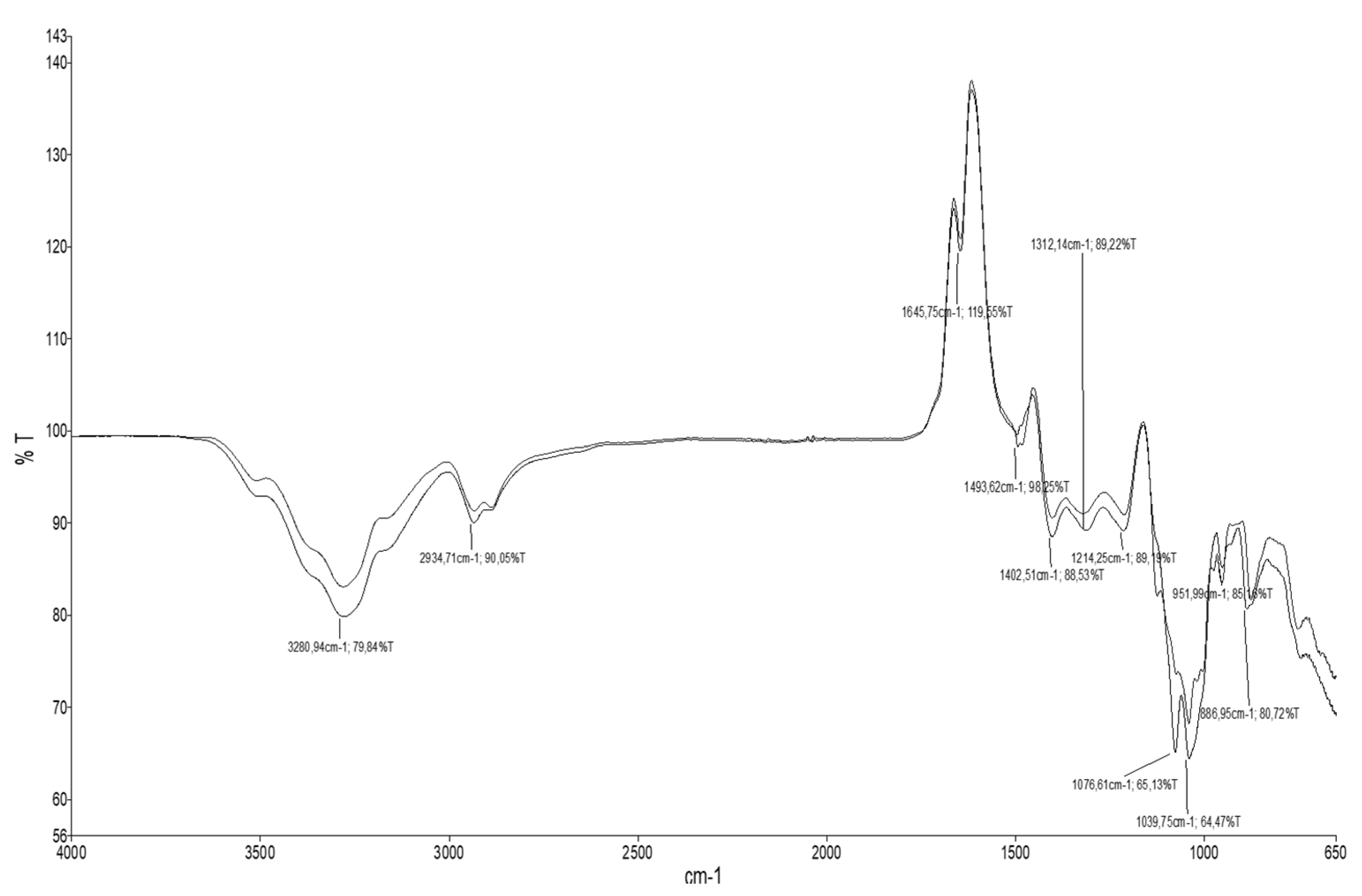
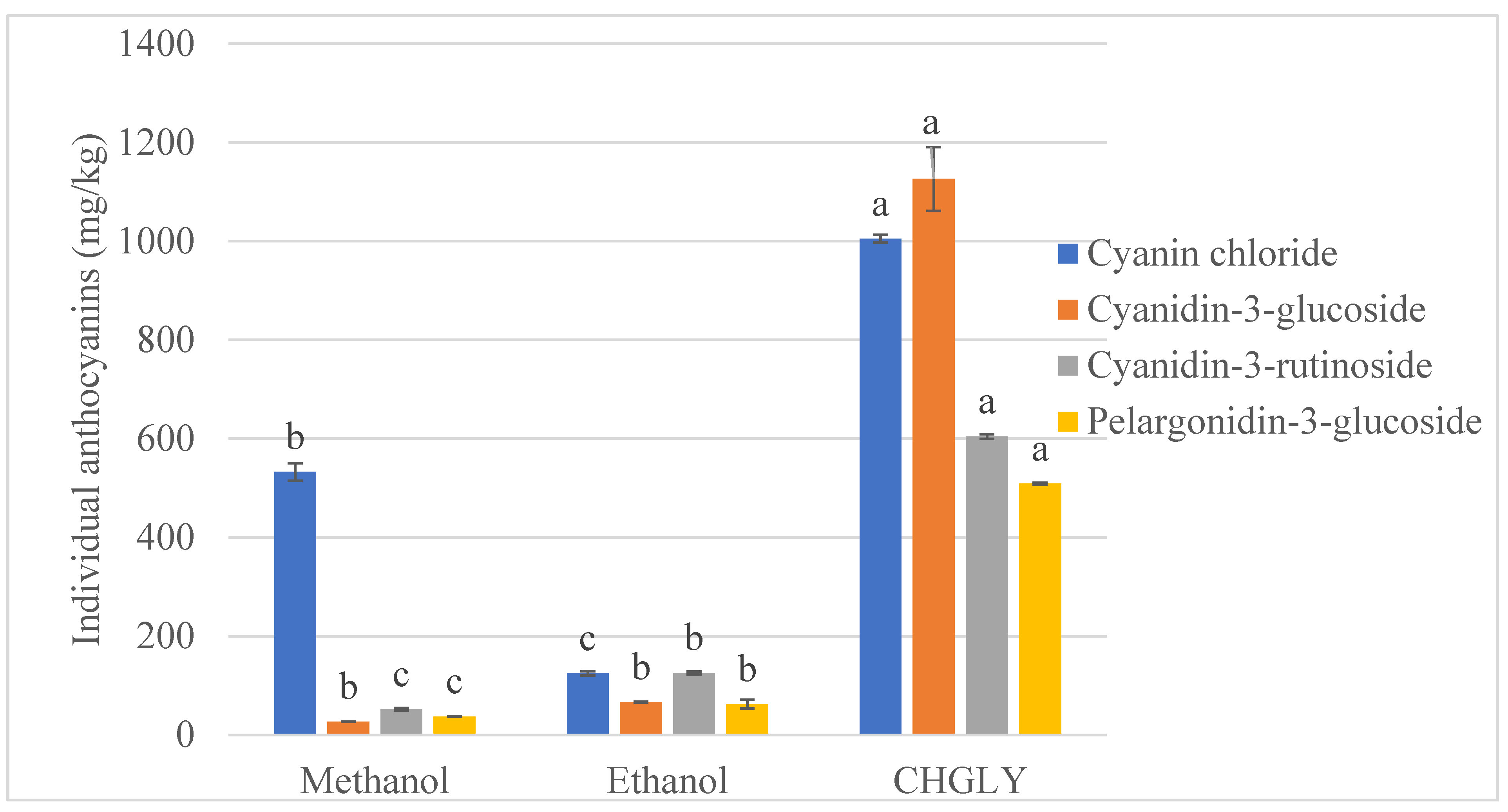


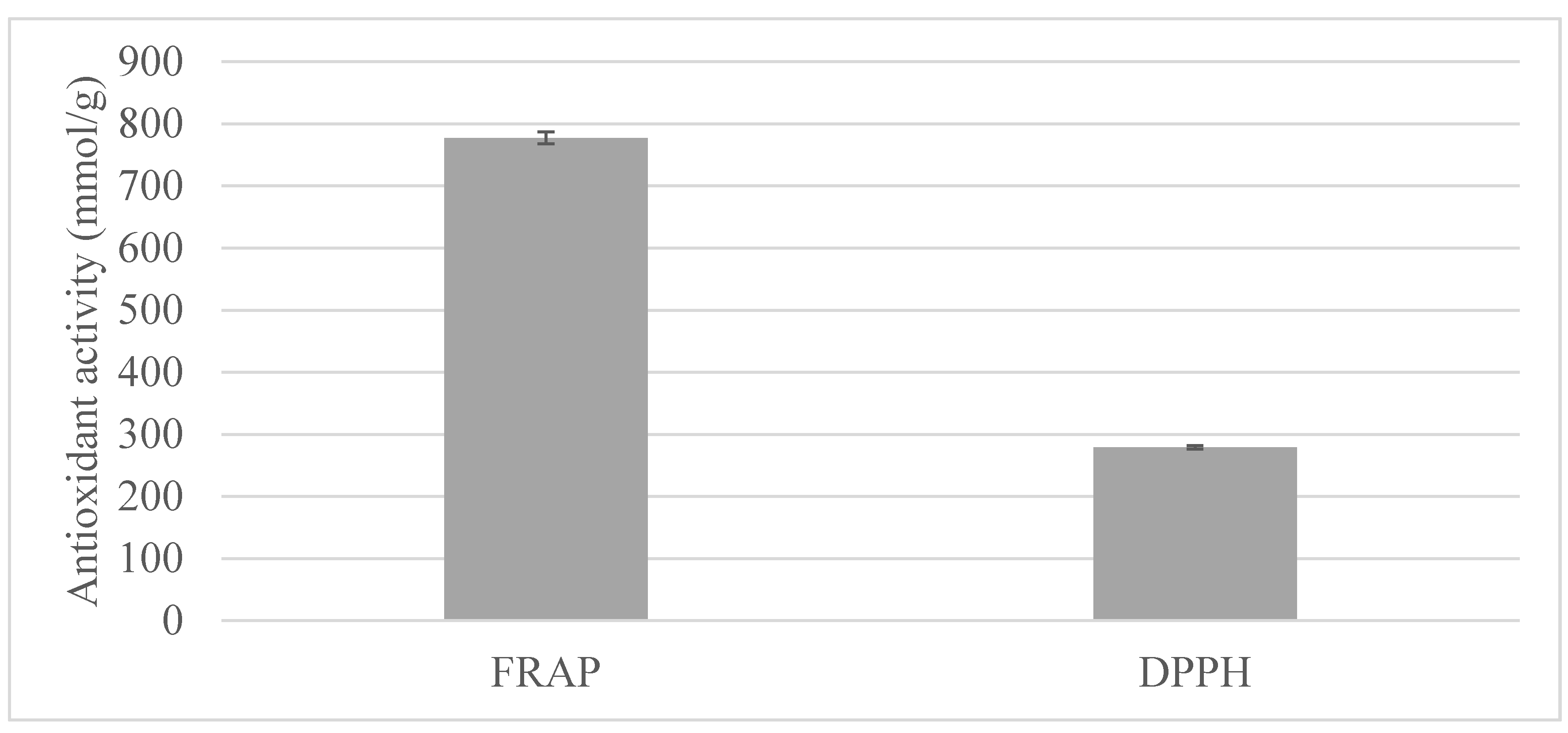
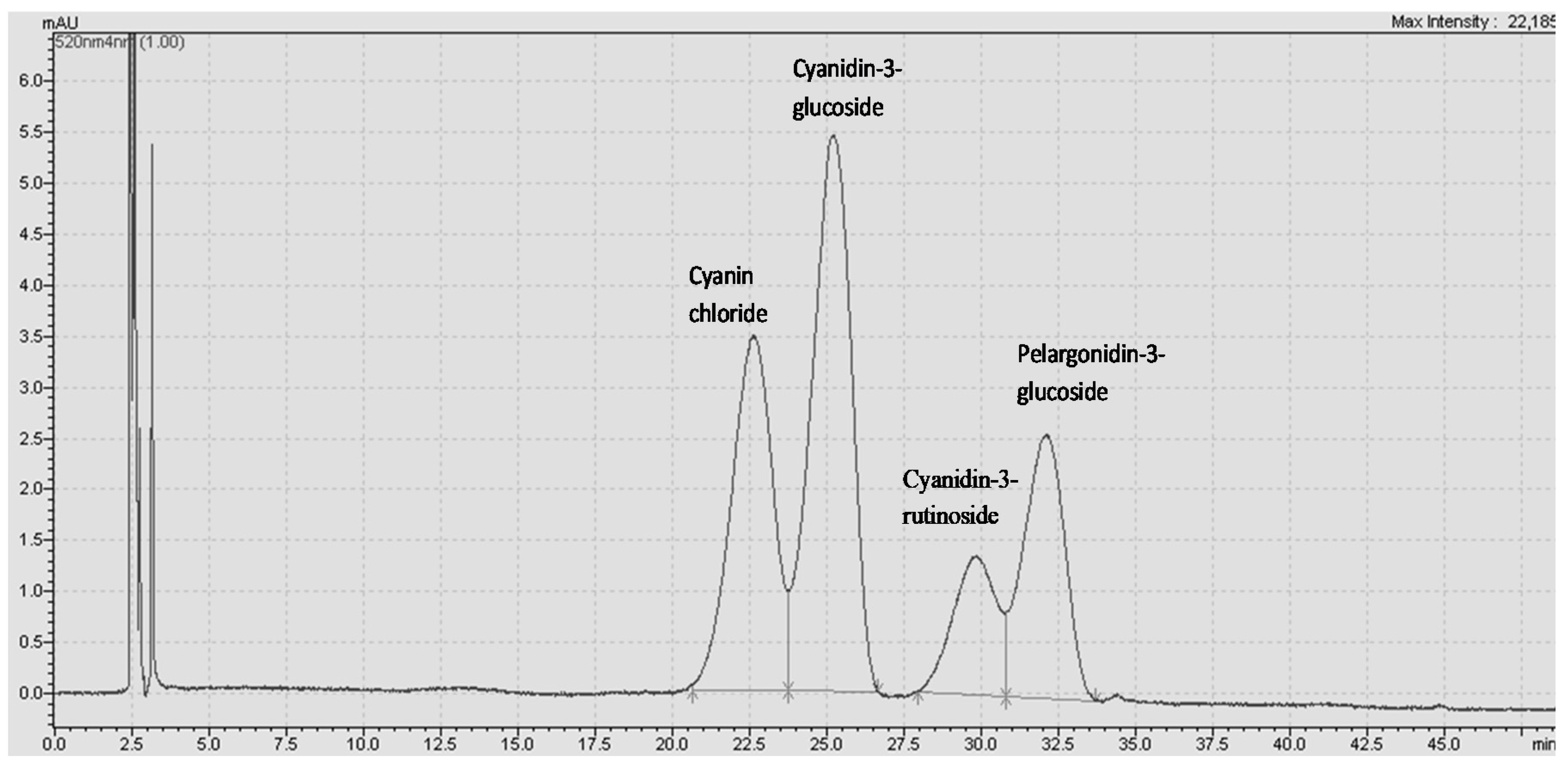

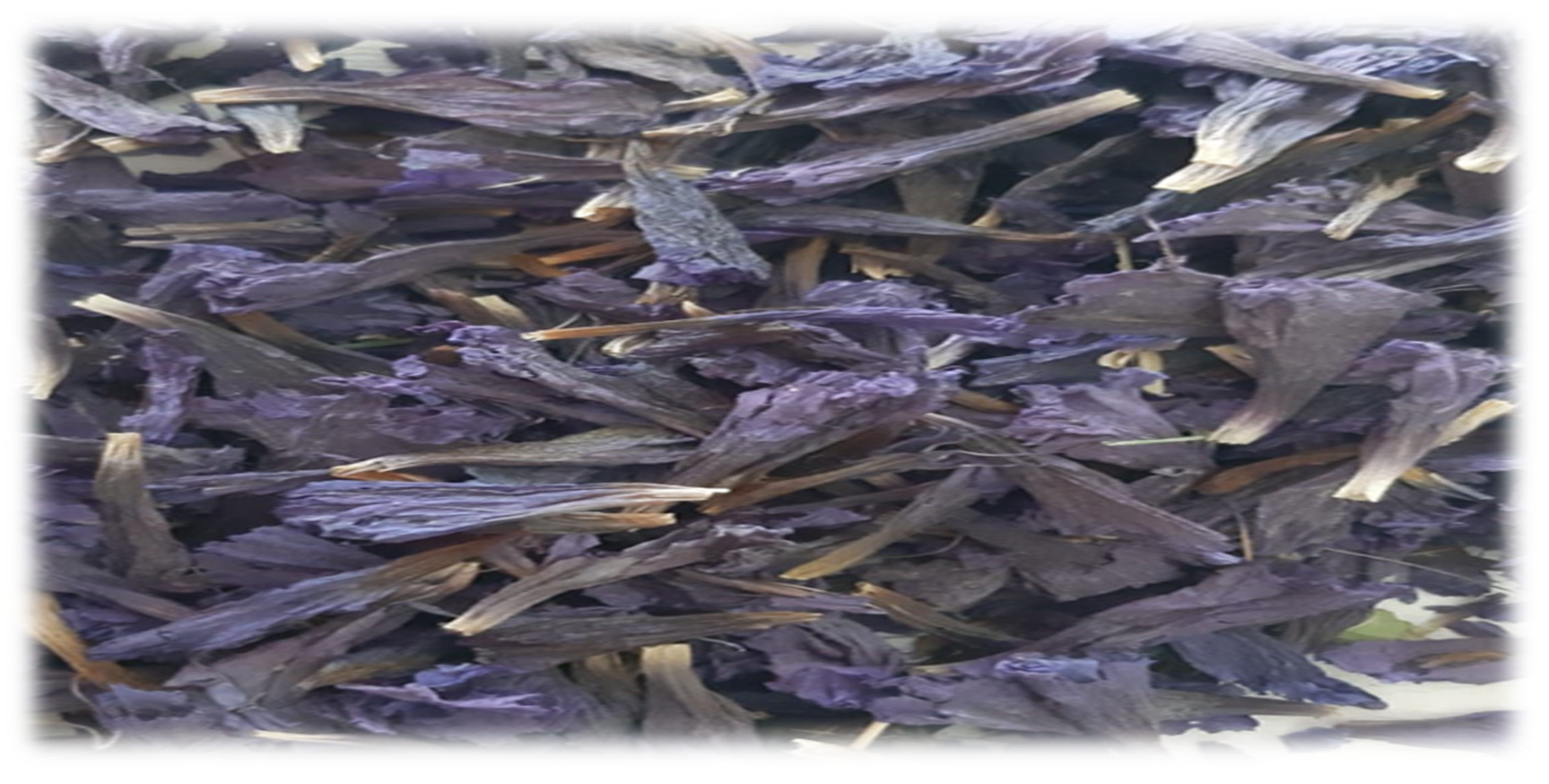
| Solvents | Phytochemical Characteristics | ||||
|---|---|---|---|---|---|
| TAC | TPC | TFC | DPPH | FRAP | |
| CHGLY | 2.61 ± 0.28 a | 27.76 ± 0.31 a | 10.29 ± 0.80 a | 146.92 ± 11.84 a | 939.85 ± 16.35 a |
| Ethanol | 0.07 ± 0.03 c | 10.08 ± 0.80 c | 2.34 ± 0.44 c | 48.35 ± 5.26 b | 444.73 ± 1.52 d |
| Water | n.d. | 26.50 ± 0.42 a | 5.36 ± 0.36 b | 124.61 ± 10.52 a | 665.53 ± 0.00 b |
| Methanol | 1.41 ± 0.11 b | 20.33 ± 2.14 b | 8.29 ± 0.26 a | 120.89 ± 3.95 a | 482.81 ± 6.83 c |
| Run | X1 | X2 | X3 | X4 | TAC | TPC | TFC | FRAP | DPPH | Cyanin Chloride | Cyanidin-3-Glucoside | Cyanidin-3-Rutinoside | Pelargonidin-3-Glucoside |
|---|---|---|---|---|---|---|---|---|---|---|---|---|---|
| 1 | 5 | 40 | 40 | 35 | 3.92 | 38.44 | 18.90 | 795.47 | 189.52 | 860.61 | 10.16 | 410.84 | 237.87 |
| 2 | 5 | 40 | 75 | 35 | 4.06 | 45.41 | 23.06 | 824.8 | 214.17 | 834.99 | 968.08 | 53.84 | 137.55 |
| 3 | 2 | 40 | 75 | 15 | 3.99 | 43.11 | 18.93 | 758.02 | 253.30 | 971.10 | 1215.04 | 127.43 | 56.25 |
| 4 | 3.5 | 30 | 90 | 25 | 4.08 | 47.93 | 25.01 | 707.33 | 332.58 | 706.11 | 879.72 | 123.73 | 68.64 |
| 5 | 3.5 | 10 | 60 | 25 | 3.11 | 28.95 | 12.85 | 571.98 | 245.81 | 406.11 | 479.72 | 607.72 | 510.31 |
| 6 | 5 | 40 | 40 | 15 | 3.40 | 35.55 | 10.54 | 782.19 | 240.55 | 1005.80 | 1273.19 | 651.01 | 507.41 |
| 7 | 2 | 20 | 40 | 15 | 3.30 | 26.96 | 12.80 | 703.36 | 148.52 | 551.66 | 677.73 | 174.02 | 374.54 |
| 8 | 5 | 20 | 75 | 15 | 4.29 | 40.44 | 22.80 | 748.41 | 280.64 | 1166.77 | 1726.42 | 397.66 | 160.64 |
| 9 | 2 | 40 | 40 | 35 | 5.69 | 45.56 | 20.39 | 755.92 | 189.52 | 507.78 | 650.27 | 410.46 | 599.86 |
| 10 | 2 | 20 | 75 | 35 | 3.55 | 39.03 | 14.65 | 622.43 | 285.88 | 879.05 | 1062.68 | 707.30 | 523.18 |
| 11 | 3.5 | 30 | 60 | 25 | 3.40 | 39.74 | 17.36 | 680.24 | 215.76 | 495.32 | 751.63 | 480.66 | 534.20 |
| 12 | 5 | 20 | 75 | 35 | 3.64 | 37.55 | 18.19 | 840.3 | 218.68 | 956.59 | 1092.72 | 380.74 | 514.11 |
| 13 | 3.5 | 30 | 60 | 45 | 4.38 | 53.20 | 26.85 | 972.43 | 335.31 | 1377.59 | 1327.59 | 330.61 | 405.41 |
| 14 | 3.5 | 30 | 60 | 25 | 3.02 | 40.22 | 16.80 | 752.76 | 217.79 | 362.74 | 493.87 | 465.40 | 726,86 |
| 15 | 5 | 40 | 75 | 15 | 5.83 | 40.44 | 18.88 | 646.61 | 229.61 | 928.25 | 1340.97 | 375.35 | 83.83 |
| 16 | 0.5 | 30 | 60 | 25 | 4.14 | 36.36 | 11.80 | 683.39 | 55.88 | 723.11 | 990.96 | 439.36 | 486.50 |
| 17 | 2 | 20 | 40 | 35 | 6.73 | 32.14 | 11.57 | 505.77 | 205.01 | 101.39 | 50.27 | 371.56 | 416.50 |
| 18 | 2 | 40 | 40 | 15 | 4.06 | 34.51 | 14.13 | 885.05 | 167.65 | 970.69 | 960.69 | 330.67 | 692.36 |
| 19 | 2 | 20 | 75 | 15 | 2.76 | 39.18 | 20.21 | 708.62 | 242.39 | 1241.75 | 763.34 | 579.17 | 220.59 |
| 20 | 5 | 20 | 40 | 15 | 2.64 | 32.29 | 12.54 | 650.81 | 291.58 | 155.38 | 1080.62 | 262.85 | 236.88 |
| 21 | 3.5 | 30 | 25 | 25 | 4.75 | 27.61 | 11.36 | 652.91 | 216.86 | 100.89 | 140.72 | 245.00 | 446.71 |
| 22 | 3.5 | 50 | 60 | 25 | 3.02 | 38.66 | 17.31 | 703.24 | 207.93 | 676.81 | 797.21 | 434.45 | 506.93 |
| 23 | 2 | 40 | 75 | 35 | 3.08 | 45.96 | 18.65 | 729.64 | 277.00 | 696.74 | 1508.97 | 68.50 | 181.60 |
| 24 | 5 | 20 | 40 | 35 | 3.76 | 35.70 | 14.08 | 705.47 | 217.77 | 18.07 | 30.45 | 116,73 | 152,115 |
| 25 | 3.5 | 30 | 60 | 25 | 3.52 | 42,66 | 13.01 | 720.18 | 204.22 | 459.71 | 637.24 | 417.58 | 627.67 |
| 26 | 3.5 | 30 | 60 | 5 | 4.43 | 45.52 | 25.47 | 884.78 | 299.75 | 1554.68 | 1798.48 | 442.14 | 144.36 |
| 27 | 6.5 | 30 | 60 | 25 | 4.25 | 33.32 | 14.29 | 768.53 | 80.13 | 844.71 | 1413.81 | 355.91 | 154.76 |
| TAC | TPC | TFC | |||||||
| SS | F-Value | p-Value | SS | F-Value | p-Value | SS | F-Value | p-Value | |
| Model | 22.46 | 19.25 | <0.0001 | 984.14 | 14.15 | <0.0001 | 543.53 | 17.56 | <0.0001 |
| X1 | 0.12 | 1.47 | 0.2489 | 1.77 | 0.3569 | 0.5613 | 6.26 | 2.83 | 0.1182 |
| X2 | 0.40 | 4.83 | 0.0484 | 177.97 | 35.82 | <0.0001 | 27.78 | 12.57 | 0.0040 |
| X3 | 0.42 | 5.09 | 0.0436 | 325.83 | 65.58 | <0.0001 | 194.39 | 87.95 | <0.0001 |
| X4 | 0.78 | 9.32 | 0.0100 | 77.57 | 15.61 | 0.0019 | 6.01 | 2.72 | 0.1250 |
| X1 X2 | 0.36 | 4.37 | 0.0585 | 20.16 | 4.06 | 0.0669 | 5.18 | 2.34 | 0.1518 |
| X1 X3 | 6.95 | 83.42 | <0.0001 | 2.87 | 0.5779 | 0.4618 | 11.17 | 5.06 | 0.0441 |
| X1 X4 | 2.05 | 24.60 | 0.0003 | 6.96 | 1.40 | 0.2595 | 6.61 | 2.99 | 0.1094 |
| X2 X3 | 0.2236 | 2.68 | 0.1273 | 4.58 | 0.9212 | 0.3561 | 5.31 | 2.40 | 0.1470 |
| X2 X4 | 1.70 | 20.43 | 0.0007 | 16.42 | 3.31 | 0.0941 | 50.36 | 22.78 | 0.0005 |
| X3 X4 | 5.54 | 66.53 | <0.0001 | 19.19 | 3.86 | 0.0730 | 28.30 | 12.81 | 0.0038 |
| X1 X1 | 1.00 | 12.01 | 0.0047 | 51.18 | 10.30 | 0.0075 | 15.50 | 7.01 | 0.0213 |
| X2 X2 | 0.1001 | 1.20 | 0.2946 | 69.92 | 14.07 | 0.0028 | 2.45 | 1.11 | 0.3132 |
| X3 X3 | 1.56 | 18.71 | 0.0010 | 10.11 | 2.04 | 0.1792 | 6.05 | 2.74 | 0.1239 |
| X4 X4 | 1.55 | 18.62 | 0.0010 | 94.74 | 19.07 | 0.0009 | 128.23 | 58.01 | <0.0001 |
| Residual | 1.00 | 59.62 | 26.52 | ||||||
| Lack of Fit | 0.8602 | 1.23 | 0.5291 | 54.72 | 2.23 | 0.3489 | 15.28 | 0.2719 | 0.9365 |
| Pure error | 0.1398 | 4.90 | 11.24 | ||||||
| Cor. total | 23.46 | 1043.76 | 570.05 | ||||||
| R2 | 0.9574 | 0.9429 | 0.9535 | ||||||
| Adj. R2 | 0.9076 | 0.8762 | 0.8992 | ||||||
| Pred. R2 | 0.7684 | 0.6985 | 0.8107 | ||||||
| Adeq. Precision | 18.66 | 15.19 | 13.92 | ||||||
| C.V. % | 7.30 | 5.75 | 8.68 | ||||||
| FRAP | DPPH | Cyanin Chloride | |||||||
| SS | F-Value | p-Value | SS | F-Value | p-Value | SS | F-Value | p-Value | |
| Model | 2.43 × 105 | 21.20 | <0.0001 | 1.05 × 105 | 31.39 | <0.0001 | 3.86 × 106 | 27.02 | <0.0001 |
| X1 | 10,040.96 | 12.29 | 0.0043 | 1225.33 | 5.13 | 0.0428 | 2469.16 | 0.24 | 0.6315 |
| X2 | 39,400.87 | 48.22 | <0.0001 | 1758.35 | 7.36 | 0.0189 | 2.28 × 105 | 22.41 | 0.0005 |
| X3 | 1473.65 | 1.80 | 0.2041 | 15,059.88 | 63.04 | <0.0001 | 9.29 × 105 | 91.08 | <0.0001 |
| X4 | 148.28 | 0.1815 | 0.6777 | 7.17 | 0.03 | 0.8654 | 2.602 × 105 | 25.52 | 0.0003 |
| X1 X2 | 14,662.44 | 17.94 | 0.0012 | 1233.55 | 5.16 | 0.0423 | 57,645.47 | 5.65 | 0.0349 |
| X1 X3 | 1555.50 | 1.90 | 0.1928 | 7386.77 | 30.92 | 0.0001 | 2802.53 | 0.27 | 0.6096 |
| X1 X4 | 37,957.63 | 46.45 | <0.0001 | 7559.31 | 31.64 | 0.0001 | 58,116.76 | 5.70 | 0.0343 |
| X2 X3 | 24,007.45 | 29.38 | 0.0002 | 27.53 | 0.12 | 0.7401 | 7.013 × 105 | 68.79 | <0.0001 |
| X2 X4 | 1831.85 | 2.24 | 0.1601 | 13.84 | 0.06 | 0.8138 | 2133.24 | 0.21 | 0.6555 |
| X3 X4 | 11,797.43 | 14.44 | 0.0025 | 129.72 | 0.54 | 0.4754 | 6482.65 | 0.64 | 0.4407 |
| X1 X1 | 0.0004 | 5.34 × 107 | 0.9994 | 26,500.12 | 110.92 | <0.0001 | 1.382 × 105 | 13.55 | 0.0031 |
| X2 X2 | 10,571.53 | 12.94 | 0.0037 | 486.45 | 2.04 | 0.1791 | 8027.43 | 0.79 | 0.3923 |
| X3 X3 | 2920.94 | 3.57 | 0.0830 | 7043.70 | 29.48 | 0.0002 | 1740.12 | 0.17 | 0.6868 |
| X4 X4 | 55,583.85 | 68.03 | <0.0001 | 16,268.41 | 68.09 | <0.0001 | 1.358 × 106 | 133.25 | <0.0001 |
| Residual | 9805.10 | 2866.95 | 1.223 × 105 | ||||||
| Lack of Fit | 7166.32 | 0.5432 | 0.7914 | 2759.73 | 5.15 | 0.1735 | 1.129 × 105 | 2.40 | 0.3300 |
| Pure error | 2638.78 | 107.22 | 9416.00 | ||||||
| Cor. total | 2.524 × 105 | 1.078 × 105 | 3.979 × 106 | ||||||
| R2 | 0.9611 | 0.9734 | 0.9693 | ||||||
| Adj. R2 | 0.9158 | 0.9424 | 0.9334 | ||||||
| Pred. R2 | 0.8086 | 0.8511 | 0.8309 | ||||||
| Adeq. Precision | 19.43 | 22.77 | 21.88 | ||||||
| C.V. % | 3.91 | 6.88 | 13.94 | ||||||
| Cyanidin-3-glucoside | Cyanidin-3-rutinoside | Pelargonidin-3-glucoside | |||||||
| SS | F-Value | p-Value | SS | F-Value | p-Value | SS | F-Value | p-Value | |
| Model | 6.03 × 106 | 21.51 | <0.0001 | 7.50 × 105 | 24.74 | <0.0001 | 1.06 × 106 | 21.20 | <0.0001 |
| X1 | 89,142.53 | 4.45 | 0.0566 | 3137.70 | 1.45 | 0.2520 | 1.24 × 105 | 34.50 | <0.0001 |
| X2 | 1.83 × 105 | 9.14 | 0.0106 | 29,562.93 | 13.65 | 0.0031 | 136.08 | 0.0380 | 0.8487 |
| X3 | 1.72 × 106 | 85.62 | <0.0001 | 5654.72 | 2.61 | 0.1321 | 2.07 × 105 | 57.68 | <0.0001 |
| X4 | 9.16 × 105 | 45.70 | <0.0001 | 14,820.72 | 6,84 | 0.0226 | 34,969.07 | 9.77 | 0.0088 |
| X1 X2 | 2.81 × 105 | 14.00 | 0.0028 | 94,259.78 | 43.52 | <0.0001 | 532.96 | 0.1489 | 0.7064 |
| X1 X3 | 20,386.20 | 1.02 | 0.3330 | 12,004.45 | 5.54 | 0.0364 | 44,806.23 | 12.52 | 0.0041 |
| X1 X4 | 5.532 × 105 | 27.61 | 0.0002 | 71,727.02 | 33.12 | <0.0001 | 6581.42 | 1.84 | 0.2001 |
| X2 X3 | 28,332.30 | 1.41 | 0.2574 | 3.35 × 105 | 154.77 | <0.0001 | 2.04 × 105 | 56.97 | <0.0001 |
| X2 X4 | 8081.15 | 0.40 | 0.5373 | 30,922.98 | 14.28 | 0.0026 | 39620.95 | 11.07 | 0.0060 |
| X3 X4 | 5.30 × 105 | 26.46 | 0.0002 | 1660.45 | 0.77 | 0.3985 | 1.00 × 105 | 27.93 | 0.0002 |
| X1 X1 | 4.00 × 105 | 19.95 | 0.0008 | 7489.71 | 3.46 | 0.0876 | 1.40 × 105 | 39.03 | <0.0001 |
| X2 X2 | 571.82 | 0.03 | 0.8687 | 3259.60 | 1.50 | 0.2434 | 24,047.83 | 6.72 | 0.0236 |
| X3 X3 | 17,986.51 | 0.90 | 0.3621 | 1.19 × 105 | 54.92 | <0.0001 | 2.22 × 105 | 62.11 | <0.0001 |
| X4 X4 | 1.11 × 106 | 55.22 | <0.0001 | 9929.23 | 4.58 | 0.0535 | 1.82 × 105 | 50.94 | <0.0001 |
| Residual | 2,40 × 105 | 25,991.61 | 42,958.12 | ||||||
| Lack of Fit | 2.07 × 105 | 1.24 | 0.5262 | 23,826.04 | 2.20 | 0.3527 | 24,394.65 | 0.26 | 0.9409 |
| Pure error | 33,361.53 | 2165.57 | 18,563.47 | ||||||
| Cor. total | 6.273 × 106 | 7.76 × 105 | 1.11 × 106 | ||||||
| R2 | 0.9617 | 0.9665 | 0.9611 | ||||||
| Adj. R2 | 0.9170 | 0.9275 | 0.9158 | ||||||
| Pred. R2 | 0.7983 | 0.8192 | 0.8348 | ||||||
| Adeq. Precision | 18.20 | 18.69 | 15.20 | ||||||
| C.V. % | 15.84 | 12.87 | 16.64 |
| Coded Values | Actual Values | |||
|---|---|---|---|---|
| X1 | X2 | X3 | X4 | |
| −1.41 | 0.5 | 10 | 25 | 5 |
| −1 | 2 | 20 | 40 | 15 |
| 0 | 3.5 | 30 | 60 | 25 |
| +1 | 5 | 40 | 75 | 35 |
| +1.41 | 6.5 | 50 | 90 | 45 |
Publisher’s Note: MDPI stays neutral with regard to jurisdictional claims in published maps and institutional affiliations. |
© 2021 by the authors. Licensee MDPI, Basel, Switzerland. This article is an open access article distributed under the terms and conditions of the Creative Commons Attribution (CC BY) license (https://creativecommons.org/licenses/by/4.0/).
Share and Cite
Zannou, O.; Pashazadeh, H.; Ghellam, M.; Ibrahim, S.A.; Koca, I. Extraction of Anthocyanins from Borage (Echium amoenum) Flowers Using Choline Chloride and a Glycerol-Based, Deep Eutectic Solvent: Optimization, Antioxidant Activity, and In Vitro Bioavailability. Molecules 2022, 27, 134. https://doi.org/10.3390/molecules27010134
Zannou O, Pashazadeh H, Ghellam M, Ibrahim SA, Koca I. Extraction of Anthocyanins from Borage (Echium amoenum) Flowers Using Choline Chloride and a Glycerol-Based, Deep Eutectic Solvent: Optimization, Antioxidant Activity, and In Vitro Bioavailability. Molecules. 2022; 27(1):134. https://doi.org/10.3390/molecules27010134
Chicago/Turabian StyleZannou, Oscar, Hojjat Pashazadeh, Mohamed Ghellam, Salam A. Ibrahim, and Ilkay Koca. 2022. "Extraction of Anthocyanins from Borage (Echium amoenum) Flowers Using Choline Chloride and a Glycerol-Based, Deep Eutectic Solvent: Optimization, Antioxidant Activity, and In Vitro Bioavailability" Molecules 27, no. 1: 134. https://doi.org/10.3390/molecules27010134
APA StyleZannou, O., Pashazadeh, H., Ghellam, M., Ibrahim, S. A., & Koca, I. (2022). Extraction of Anthocyanins from Borage (Echium amoenum) Flowers Using Choline Chloride and a Glycerol-Based, Deep Eutectic Solvent: Optimization, Antioxidant Activity, and In Vitro Bioavailability. Molecules, 27(1), 134. https://doi.org/10.3390/molecules27010134








